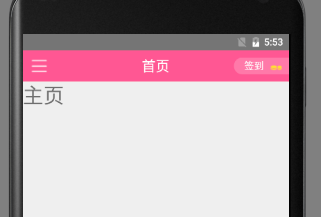android 使用Builder设计模式,设计ToolBar
使用Builder设计模式,设计ToolBar
Builder设计模式解析
android也有不地方采用了Builder设计模式的,比如NotificationCompat.Builder和AlertDialog.Builder就采用了Builder的设计模式
最典型的代码示例
NotificationCompat.Builder
NotificationCompat.Builder mBuilder =
new NotificationCompat.Builder(this)
.setSmallIcon(R.drawable.notification_icon)
.setContentTitle("My notification")
.setContentText("Hello World!");
// Creates an explicit intent for an Activity in your app
Intent resultIntent = new Intent(this, ResultActivity.class);
// The stack builder object will contain an artificial back stack for the
// started Activity.
// This ensures that navigating backward from the Activity leads out of
// your application to the Home screen.
TaskStackBuilder stackBuilder = TaskStackBuilder.create(this);
// Adds the back stack for the Intent (but not the Intent itself)
stackBuilder.addParentStack(ResultActivity.class);
// Adds the Intent that starts the Activity to the top of the stack
stackBuilder.addNextIntent(resultIntent);
PendingIntent resultPendingIntent =
stackBuilder.getPendingIntent(
0,
PendingIntent.FLAG_UPDATE_CURRENT
);
mBuilder.setContentIntent(resultPendingIntent);
NotificationManager mNotificationManager =
(NotificationManager) getSystemService(Context.NOTIFICATION_SERVICE);
// mId allows you to update the notification later on.
mNotificationManager.notify(mId, mBuilder.build());
AlertDialog.Builder
AlertDialog.Builder builder2=new AlertDialog.Builder(
getActivity(),R.style.AppTheme_NoActionBar);
builder2.setTitle("警告")
.setMessage("你确定删除吗")
new DialogInterface.OnClickListener() {
@Override
public void onClick(DialogInterface dialog,
int which) {
ToastUtil.showToast(getActivity(),"你点击了取消");
}
})
.setPositiveButton("确定",
new DialogInterface.OnClickListener() {
@Override
public void onClick(DialogInterface dialog,
int which) {
ToastUtil.showToast(getActivity(),
"你点击了确定");
}
}) .create().show();Builder设计模式的特点
参数化
AlertDialog.Builder里面会实例一个AlertController.AlertParams,里面包含大部分,创建AlertDialog的参数,实现功能的参数化
public Builder(Context context, int themeResId) {
P = new AlertController.AlertParams(new ContextThemeWrapper(context, resolveDialogTheme(context, themeResId)));
}可维护性强
由于Builder设计模式的参数,达到功能的多变,可维护性就变得很强
例如:可以 调用setMessage(“你确定删除吗”),也可以去掉
ToolBar的设计,抽象化
接口抽象toolbar的规范public interface INavigation
/**
* 所有Toolbar的规范
* 抽象一个Toolbar
*
* Created by 辉神 on 2016/8/10.
*/
public interface INavigation {
/**
* 定义布局(返回布局id)
* @return
*/
public int bindLayoutId();
/**
* 创建和绑定布局
*/
public void build();
}抽象并实现INavigation——public abstract class AbsNavigation
/**
* 再次抽象Toolbar
* -只要是app的开发,都会有布局的创建和绑定
* -再次抽象,是为了,下次使用时,不用再次创建布局和绑定
* Created by 辉神 on 2016/8/10.
*/
public abstract class AbsNavigation<P extends AbsNavigation.NavigationParams> implements INavigation {
/**
* 设置一个默认LayoutId,默认为0
*/
private static final int DEFAULT_LAYOUT_ID=0;
private P params;
private View contentView;
public AbsNavigation(P params) {
this.params = params;
}
public P getParams() {
return params;
}
@Override
public int bindLayoutId() {
return DEFAULT_LAYOUT_ID;
}
@Override
public void build() {
//创建和绑定布局
if (contentView==null)
contentView = bindParent(bindLayoutId(), ((NavigationParams)getParams()).parent);
}
/**
* 方便子类使用
* @param id
* @return
*/
public View findLayoutById(int id){
return contentView!=null?contentView.findViewById(id):null;
}
public String getString(int id){
return contentView.getContext().getResources().getString(id);
}
public View bindParent(int id, ViewGroup parent) {
//先要判断这个id是否为0
if (id==DEFAULT_LAYOUT_ID){
return null;
}
View childView = ((NavigationParams)getParams()).inflater.inflate(id, parent,false);
return bindParent(childView,parent);
}
public View bindParent(View childView, ViewGroup parent) {
ViewGroup viewParent= (ViewGroup) childView.getParent();
//如果他原来有一个爸爸了,就先把它爸爸干掉
if(viewParent!=null){
viewParent.removeView(childView);
}
//添加我们的爸爸给这个视图,因为一个视图不可能有两个爸爸
parent.addView(childView,0);
//将爸爸返回
return parent;
}
/**
* Builder设计模式,所有Toolbar都必须有的参数----------参数集(参数类)
*/
public static class NavigationParams{
private Context context;//上下文对象,用于加载布局视图
private ViewGroup parent;//每一个布局视图都有一个爸爸
private LayoutInflater inflater;
public NavigationParams(Context context, ViewGroup parent) {
this.context = context;
this.parent = parent;
inflater=inflater.from(context);
}
}
/**
* 创建Toolbar
*/
public abstract static class Builder{
public Builder(Context context,ViewGroup parent) {
}
/**
* 创建Toolbar
* @return
*/
public abstract INavigation create();
}
}
搭建toolbar布局框架——abstract class DefaultNavigation(多个子类(功能)继承此父类,功能需求就可以多变)
/**
* 左中右场场景,
* 也就是先设置左中右的布局,子类可以实现更多内容
* Created by 辉神 on 2016/8/11.
*/
public abstract class DefaultNavigation<P extends AbsNavigation.NavigationParams> extends AbsNavigation<P> {
public DefaultNavigation(P params) {
super(params);
}
@Override
public int bindLayoutId() {
return R.layout.navigation_default;
}
@Override
public void build() {
super.build();//一定要super,因为要绑定左中右的父容器
//初始化父容器,布局框架
LinearLayout ll_left= (LinearLayout) findLayoutById(R.id.ll_left);
LinearLayout ll_center= (LinearLayout) findLayoutById(R.id.ll_center);
LinearLayout ll_right= (LinearLayout) findLayoutById(R.id.ll_right);
//以下方法都是抽象,显然,子类可以任意定义布局,达到动态改变,方便维护
//绑定布局也就是,将子布局添加到当前这个“左中右场景”中来
bindParent(bindLeftLayoutId(),ll_left);
bindParent(bindCenterLayoutId(),ll_center);
bindParent(bindRightLayoutId(),ll_right);
//初始化子布局
initLeftLayout(ll_left);
initCenterLayout(ll_center);
initRightLayout(ll_right);
}
/**
*返回左边布局ID—— 用于子布局(待子类实现)
* @return ID
*/
public abstract int bindLeftLayoutId();
/**
* 返回中间布局ID—— 用于子布局(待子类实现)
* @return ID
*/
public abstract int bindCenterLayoutId();
/**
* 返回右边布局ID—— 用于子布局(待子类实现)
* @return ID
*/
public abstract int bindRightLayoutId();
/**
* 初始化左边的布局—— 用于子布局(待子类实现)
* @param view
* @return
*/
public abstract void initLeftLayout(View view);
/**
* 初始化中间的布局—— 用于子布局(待子类实现)
* @param view
* @return
*/
public abstract void initCenterLayout(View view);
/**
* 初始化右边的布局—— 用于子布局(待子类实现)
* @param view
* @return
*/
public abstract void initRightLayout(View view);
}主页toolbar的实现——HomeNavigation
/**
* 默认的主页toolbar实现
* Created by 辉神 on 2016/8/11.
*/
public class HomeNavigation extends DefaultNavigation<HomeNavigation.HomeNavigationParams> {
public HomeNavigation(HomeNavigationParams params) {
super(params);
}
/**
* 设置默认主页的参数
*/
public static class HomeNavigationParams extends AbsNavigation.NavigationParams{
public int leftImageRes;
public int centerTitleRes;
public int rightImageRes;
public int rightTextRes;
public View.OnClickListener leftOnclickListener;
public View.OnClickListener rightOnClickListener;
public HomeNavigationParams(Context context, ViewGroup parent) {
super(context, parent);
}
}
/**
* 构建我们的Toolbar
* @return
*/
public static class Builder extends AbsNavigation.Builder{
private HomeNavigationParams p;
public Builder(Context context, ViewGroup parent) {
super(context, parent);
this.p=new HomeNavigationParams(context,parent);
}
/**
* 设置左边的图片
*/
public Builder setLeftImageRes(int leftImageRes){
this.p.leftImageRes=leftImageRes;
return this;
}
/**
* 设置中间标题
* @param centerTitleRes
* @return
*/
public Builder setCenterTitleRes(int centerTitleRes){
this.p.centerTitleRes=centerTitleRes;
return this;
}
/**
* 设置右边图片
* @param rightImageRes
* @return
*/
public Builder setRightImageRes(int rightImageRes){
this.p.rightImageRes=rightImageRes;
return this;
}
/**
* 设置右边文字
* @param rightTextRes
* @return
*/
public Builder setRightTextRes(int rightTextRes){
this.p.rightTextRes=rightTextRes;
return this;
}
/**
* 设置左边监听事件
* @param leftOnclickListener
* @return
*/
public Builder setLeftOnclickListener(View.OnClickListener leftOnclickListener){
this.p.leftOnclickListener=leftOnclickListener;
return this;
}
/**
* 设置右边监听事件
* @param rightOnClickListener
* @return
*/
public Builder setRightOnClickListener(View.OnClickListener rightOnClickListener){
this.p.rightOnClickListener=rightOnClickListener;
return this;
}
/**
* <p>这个方法被调用了之后,还没有结束,还需要调用接口中的build()方法</p>
* <p>HomeNavigation的是上层父类,是INavigation的实现类,</p>
* <p>所以当前INavigation的build()方法被调用时,也就相当于接口回调了,builder设计模式也就完成</p>
* <p>用户还需要再调用最高层接口,已经设计好的方法build()方法</p>
* <p>这个builder设计模式简直屌炸天</p>
* @return
*/
@Override
public INavigation create() {
return new HomeNavigation(p);
}
}
@Override
public int bindLayoutId() {
return super.bindLayoutId();
}
@Override
public int bindLeftLayoutId() {
return R.layout.navigation_default_left;
}
@Override
public int bindCenterLayoutId() {
return R.layout.navigation_default_center;
}
@Override
public int bindRightLayoutId() {
return R.layout.navigation_home_right;
}
@Override
public void initLeftLayout(View view) {
ImageView iv_default_left = (ImageView) view.findViewById(R.id.iv_default_left);
iv_default_left.setImageResource(getParams().leftImageRes);
iv_default_left.setOnClickListener(getParams().leftOnclickListener);
}
@Override
public void initCenterLayout(View view) {
TextView tv_default_center = (TextView) view.findViewById(R.id.tv_default_center);
tv_default_center.setText(getString(getParams().centerTitleRes));
}
@Override
public void initRightLayout(View view) {
TextView tv_home_right = (TextView) view.findViewById(R.id.tv_home_right);
tv_home_right.setText(getString(getParams().rightTextRes));
tv_home_right.setOnClickListener(getParams().rightOnClickListener);
ImageView iv_home_right= (ImageView) view.findViewById(R.id.iv_home_right);
iv_home_right.setImageResource(getParams().rightImageRes);
//启动金币动画
AnimationDrawable animationDrawable= (AnimationDrawable) iv_home_right.getBackground();
animationDrawable.start();
}
}HomeNavigation的调用,即实例化
private void initNavigation(View contentView) {
HomeNavigation.Builder builder=new HomeNavigation.Builder
(getActivity(), (ViewGroup) contentView);
builder.setLeftImageRes(R.mipmap.apk_all_top_nav)
.setCenterTitleRes(R.string.tabbar_home_text)
.setRightTextRes(R.string.nav_sign_in)
.setRightImageRes(R.drawable.anim_sign_coin)
.setLeftOnclickListener(
new View.OnClickListener() {
@Override
public void onClick(View v) {
ToastUtil .showToast(getActivity(),
"点击了菜单");
}
})
.setRightOnClickListener
(new View.OnClickListener() {
@Override
public void onClick(View v) {
ToastUtil.showToast(getActivity(),
"点击了签到");
}
})
.create().build();
}主页toolbar实现效果
布局代码就不给了
关注我





 浙公网安备 33010602011771号
浙公网安备 33010602011771号